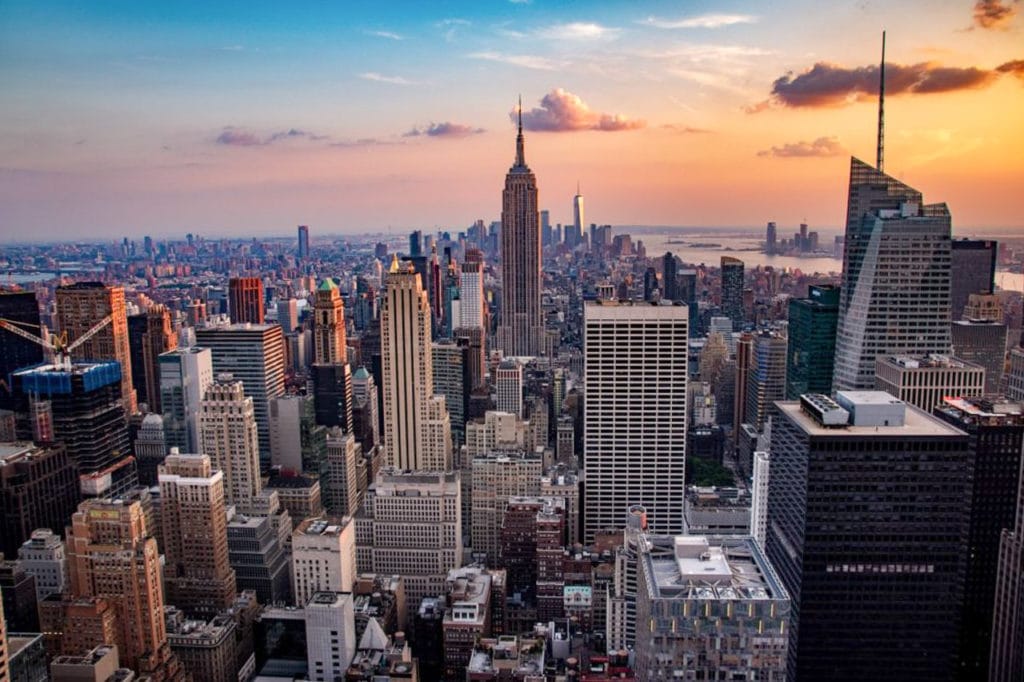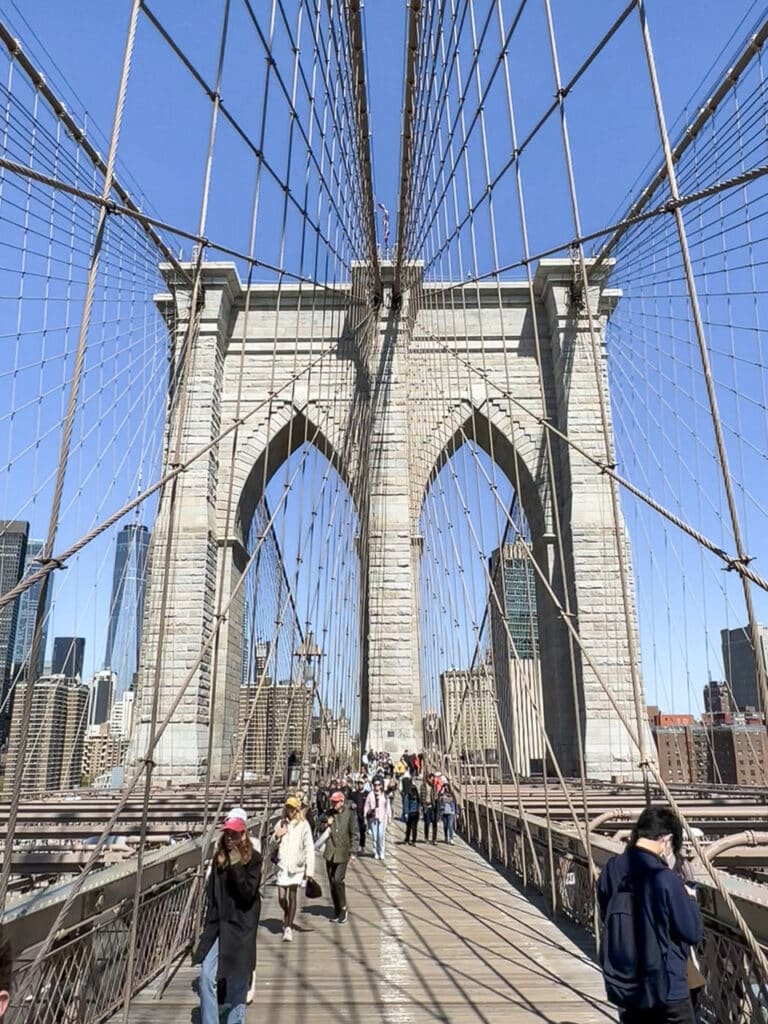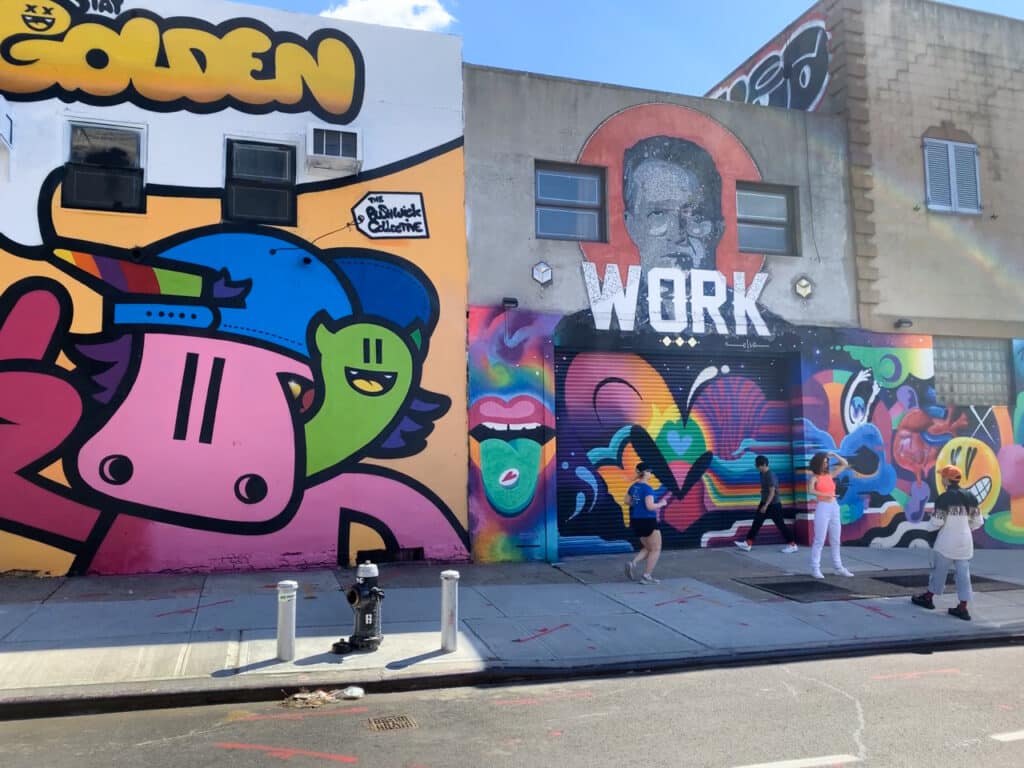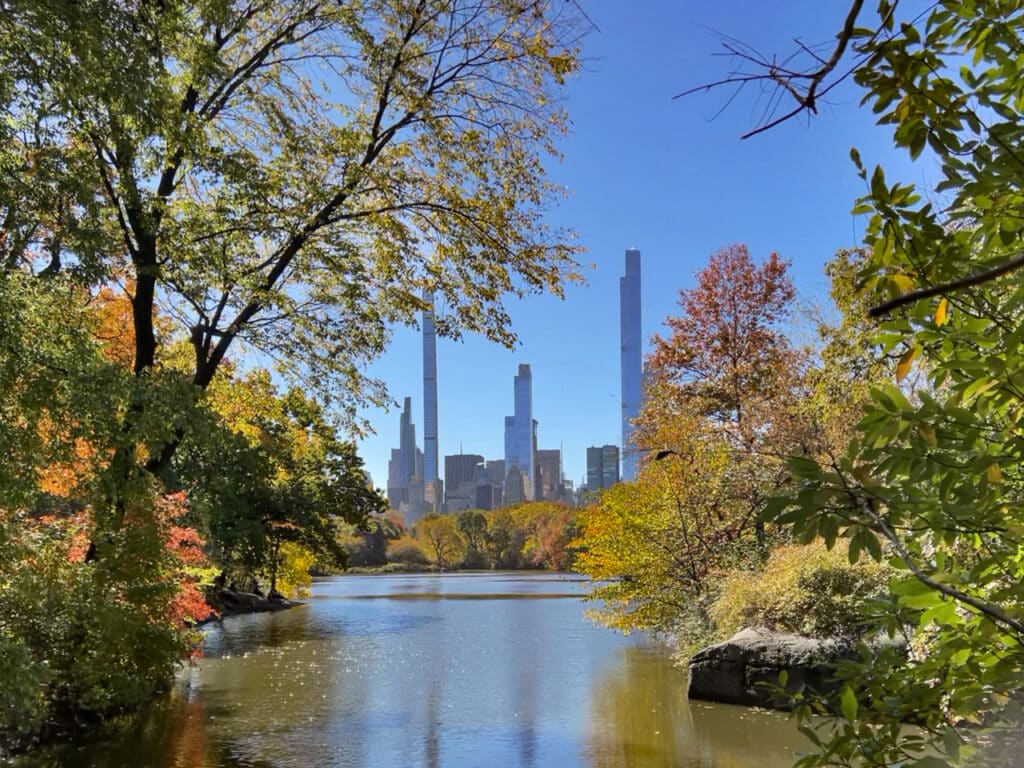
Are you planning a trip to New York City? This guide introduces some basic New York information that will be helpful as you plan your trip.
Read about sites and attractions you don’t want to miss. Or keep scrolling for information about safety, when to visit, and much more. I’ve also included my own tips for visiting the most exciting city in the world. Happy planning and have a fabulous time in the Big Apple!
About New York City

New York City is in the northeastern region of the United States. The city is part of New York State, however, contrary to popular belief, it is not the state capital. That honor goes to Albany, which is more centrally located within the state of New York.
The double naming—New York, New York—does it make things a bit confusing. If I tell people I’m from New York, that should imply I’m from somewhere in the state, meaning I might be from Albany, Buffalo, Montauk, Elmira, Plattsburgh, or any one of the hundreds of towns and cities in New York.
However, that declaration often leads to the automatic assumption that I grew up in New York City, whereas NYC is simply one of many cities in New York. Because the city has such a large personality and presence in movies, television, and culture, it has co-opted the identity of the state as a whole. This dilemma is not good or bad; it merely seems an unavoidable fact.
Five boroughs make up New York City. Those boroughs are Manhattan, the Bronx, Brooklyn, Queens, and Staten Island. Manhattan and Staten Island are islands while Brooklyn and Queens are part of the land mass that make up Long Island. The Bronx is the northernmost borough and is attached to the mainland.

The length of Manhattan is 13.4 miles from north to south. The waterways that make it an island are the Hudson River on the west side, the East River to the east, the Harlem River at its northern tip. To the south, the New York Harbor empties into the New York Bay, which leads to the Atlantic Ocean.
Within each borough are many, many neighborhoods such as SoHo in Manhattan, Greenpoint in Brooklyn, and Astoria in Queens. Neighborhoods have their own flair and personality. Some reflect the dominant ethnic groups that reside there while others are a mix of people from many cultural and language backgrounds. I hope that wherever you visit in New York City, you’ll experience the wonderful diversity that makes it such an incredible place.
As of the 2020 census, the population of New York City is just over 8.8 million people, making it the largest city in the U.S. by population. For comparison, Los Angeles is the second largest city, with just under 4 million residents.
Approximate distance and driving time from New York City to major cities:
- Philadelphia, PA: 95 miles (153 km). 2 hours.
- Albany, NY: 150 miles (240 km). 2.5-3 hours.
- Boston, MA: 215 miles (345 km). 3 hours & 45 minutes.
- Washington D.C.: 230 miles (370 km). 4.5 hours.
- Montreal, Canada: 375 miles (600 km). 6 hours.
Things to do in New York City
There is something for everyone in New York City, whether it’s your first or 50th time visiting.
For first-time visitors, I highly recommend seeing the major tourist attractions like the Statue of Liberty and Ellis Island, Times Square, Central Park, Brooklyn Bridge, Metropolitan Museum of Art, and the Charging Bull of Wall Street.
After you’ve seen the major sites, you may want to visit the newer landmarks like Little Island, the High Line, and Hudson Yards.
Non-Touristy Things to do in New York City
If you’ve been to New York City many times and want to get off the beaten path, there are plenty of ways to do that, too!
In fact, one specialty of From Inwood Out is on things to do in Inwood, my Upper Manhattan neighborhood where I’ve lived since 2009! Things don’t much more non-touristy than an off-the-beaten-path residential NYC neighborhood. Check all there is to do in Inwood.
And all over New York City, there are museums and attractions that are lesser known but no less fabulous. Consider, for example, the Brooklyn Museum, the Studio Museum in Harlem, or the Museum of the Moving Image in Queens.
New York City is also famous for its diversity of restaurants and cuisines. Old favorites include Junior’s Cheesecake, Carmine’s, Grand Central Oyster Bar, and Katz’s Deli. The best pizza is whichever pizzeria you happen to be near, but old stand-bys include John’s of Bleecker St., Grimaldi’s, and Lombardi’s.
Bagels so perfect you want to cry are everywhere. Try them at Murray’s Bagels in Greenwich Village, Zabar’s or Barney Greengrass on the Upper West Side, Russ & Daughters on the Lower East Side, or Brooklyn Bagel & Coffee Company (multiple locations).
Planning a trip to New York City can be overwhelming, especially for first-time visitors. Whether you plan out every detail of every day or just wing it and strike out on the city without a schedule, remember to be flexible, wear comfortable shoes, and have an amazing time!
American History in New York City

New York plays a huge role in the history of the United States. It was, after all, the first capital of the U.S. and George Washington took the first presidential oath here. But the history dates back even further than that.
Dutch families began arriving in what is now New York in 1624, establishing settlements up and down the Hudson River and Atlantic coast. The colony was named New Netherland, which the Dutch controlled until 1664, when the English took over by force.
The Dutch first brought enslaved African men to New Amsterdam (present-day Manhattan) in 1626. The cruel use of slave labor continued throughout the colony during British rule and long after the American Revolution established the U.S. as a new country. Slavery officially ended in New York State in 1827.
Signs of this history still exist in modern-day New York City. The African Burial Ground commemorates the site where the remains of enslaved and free Africans were discovered in 1991. The skeletal remains date from the 1630s to 1795 and are entombed here.
I also recommend checking out the National Museum of the American Indian to learn more about Native American tribes who originally inhabited this region and were casualties of colonialization.
Colonial-era homes still standing include the Dyckman Farmhouse Museum, Morris-Jumel Mansion, and the Van Cortlandt House Museum. Visitors can also tour the home where Alexander Hamilton lived at the time of his death.
Fast forwarding a century or so, remnants from New York City’s Gilded Age in the 19th century are scattered around Manhattan, as are landmarks that tell stories of the city’s immigration history.
Fascinated by mid-20th century history? Be sure to visit the TWA Hotel at JFK Airport!
Best Time of Year to Visit NYC
Tourist season lasts for most of the year in New York City, with the exception of the slow months of January and February. The busiest tourist seasons are the summer months of June-August and Christmas season, which is from November-December. Here are some pros and cons for visiting at different times of year.
Summer: June-August
- Pros: Sunny days, warm nights, free outdoor movies, concerts, and festivals. Beach days at Coney Island.
- Cons: Peak tourist season means crowds and higher hotel prices. Weather may be uncomfortably humid. Subway platforms are sweltering, though subway cars are air-conditioned.
Fall: September-November
- Pros: Cool temperatures and autumn colors. Tourist crowds thin out somewhat. It’s Halloween!
- Cons: Not many cons of visiting in the fall except potentially cold, rainy weather.
Christmas Season: Mid-November-December
- Pros: Christmas decorations, Winter Villages, the Rockettes, ice skating, the overall magic of the holiday season.
- Cons: Peak season means crowded attractions and higher hotel prices. Weather may be very cold.
Winter: January-February
- Pros: Clear sunny days, snowy days, excuse to drink lots of hot chocolate. Low tourist season means thinner crowds, lower hotel prices, and more availability at major landmarks. January and February are the cheapest months to visit.
- Cons: Weather may be bitterly cold. Heavy snowstorms may briefly close major attractions and disrupt subways.
Spring: March-May
- Pros: Blooming cherry blossoms, tulips, and daffodils; baseball season.
- Cons: May be rainy and/or windy; temperatures are unpredictable.
Staying Safe in New York City
Though crimes rates have risen since the onset of the COVID-19 pandemic, New York City remains one of the safest big cities in the world. However, crime does occur and it’s important to take some precautions to assure you stay safe.
Most tips for staying safe in New York apply to any large city: be aware of your surroundings, don’t flaunt cash or valuables, don’t walk in desolate areas, etc. Here are some specific New York safety tips I recommend following:
- As a rule, don’t hang out in city parks after dark. If a special event is taking place in the park, follow the crowd in and follow the crowd out.
- While waiting for the subway, stand back from the train tracks until the train is in the station. It’s gruesome and awful to think about, but people have been pushed into oncoming trains.
- Try not to ride in an empty subway car but if you must, ride in the car where the conductor is. You should see their head sticking out of a train car window near the middle of the train at each stop.
- Never hesitate to ask for help. Ask subway riders, locals, or police officers for directions or assistance. Step into a bodega or other shop if you feel unsafe on a street.
Tips for Visiting NYC From a Local

I’ve lived in New York for almost 13 years and here’s some knowledge I’ve gained during those years that I love to pass on:
- Greenwich Village is pronounced GREN-ich Village.
- Houston, a major street in Lower Manhattan, is pronounced HOW-ston.
- Carry some small bills to purchase food from food carts and merchandise from street vendors. Also, some stores won’t accept bills higher than a $20.
- Don’t carry large amounts of cash. Credit or debit cards are the way to go.
- Stay in a centrally located hotel. If you try to save money by staying in New Jersey, you’ll spend a lot of extra money, not to mention time, on commuting into the city.
- Wear the most comfortable shoes you own and walk as much as possible.
- While walking, don’t allow your group to take up the full width of a sidewalk. Allow room for other pedestrians to pass.
- Don’t stop suddenly to take a photo or look at your phone. Step aside out of the way first.
- Try to get away from the major tourist sites, at least for a couple of hours. You’ll see an entirely different side of New York if you do.
Common New York Nicknames
- The Big Apple-The use of this nickname is traced back to a 1920s sportswriter for a local newspaper. However a tourism campaign in the 1970s is what made it ubiquitous.
- The city that never sleeps-The subway runs all night long and many bodegas and cafes are open 24 hours, catering to cab drivers, hospital staff, and other overnight workers. Times Square is also lit up so bright it looks like daytime all night long.
- The city so nice they named it twice-A play on the fact that New York City is part of New York State, hence: New York, New York.
- Finally, residents of nearby cities and states may refer to New York simply as The City.
How to get around NYC
Walk: New York is a walking city and if you’re able to walk long distances, I highly recommend that being your main mode of getting around New York City. Walking provides endless opportunities to see New York in action.
The streets of Manhattan above Houston and below 155th were designed on a grid system. Streets run north and south while avenues run east and west, a pattern which makes it easy to orient yourself. For example, if you’ve walked from W. 21st St. to W. 23rd St., you’re heading north. If you’ve walked from 7th Ave. to 9th Ave., you’ve gone two blocks to the west.
Broadway stretches through the entire length of Manhattan and up into the Bronx. Central Park lies from 59th St. to 110th St. between Central Park West and Fifth Avenue.
Take the subway: When it’s too far to walk, the New York City subway is the most convenient way to get around. The subway system is extensive, taking riders almost anywhere in the city they need to go. The cost of $2.75 per ride remains the same no matter how far you travel. There are also options for weekly and monthly subway passes. Click below for a few tips on taking the subway
Take the NYC Ferry: The ferry is a scenic, inexpensive, time-saving mode of transportation that connects New York City’s waterfront communities such as Red Hook, Rockaway Beach, Long Island City, and Roosevelt Island. Like the subway, the NYC Ferry costs $2.75 per ride.
Hail a cab: Try to position yourself in the direction you are heading and stand on the on the appropriate side of the street. To hail a cab, simply stand at the curb or step carefully into the street. Raise your arm above your head when you see a taxi approaching. Hop in and inform the driver of your destination. Taxi’s accept cash and credit as payment. Of course, car services like Uber and Lyft are prevalent in New York City but the yellow cab remains an NYC icon.